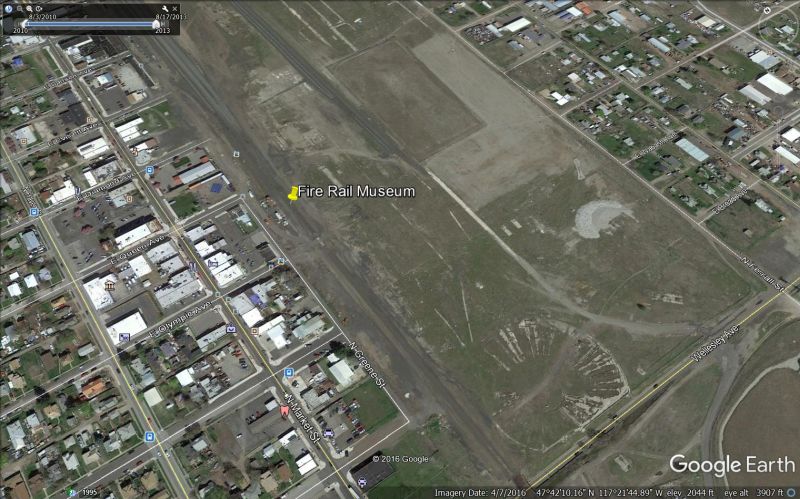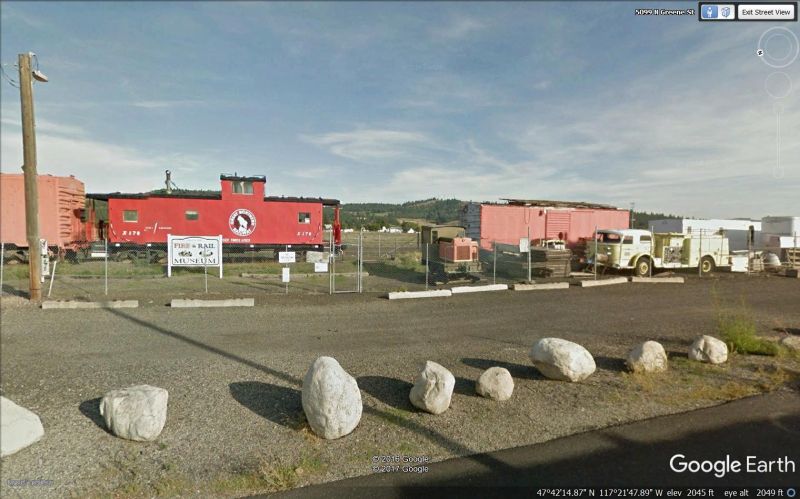And now it is a vast contaminated oil drenched site down to about 120 feet. BNSF, the State of Washington and the EPA are working on a way of solving the spill before the freeway goes any farther south.
Here’s another interesting tidbit I found at the Hillyard site on Google Earth. There is a Fire Rail Museum on N. Greene Street.


Here’s some history about Hillyard.
"In the 1880s, Spokane was becoming the premier rail hub of the West and tycoon James J. Hill wanted it on his Great Northern line to the coast. The first GN train rolled into Spokane in May 1892, starting a long association between the company and the city.
Because Hill was trying to catch up to the Northern Pacific and others, he needed a right of way through Spokane. He dropped hints that he could drop shipping rates if he was given the land and rights of way he needed. Although he eventually got the land, the shipping rates, which made everything more expensive in Spokane, never came down. But Hill went on to build a new station on Havermale Island downtown.
Another clever dodge was the placement of the extensive rail yard outside city limits to avoid city taxes. The yard would become the biggest rail shop west of the Mississippi, including a 20-stall engine house and shops to repair engines and rail cars. The Hillyard shops produced the largest and most powerful steam engine to date, the R-1 Mallet, based on the designs of Swiss inventor Anatole Mallet. Between 1927 and 1930, 26 were built there.
It would be another decade or so before diesel-electric engines began to replace steam power. As diesels became common, Hillyard got some of the work, but other repair centers grew, too. In 1968, the GN merged with the Northern Pacific and other lines to form the Burlington Northern. Repair work and jobs were consolidated and moved to other areas of the country, and Hillyard lost hundreds of jobs.
To fight the economic losses, the Hillyard Development Corp. and the Hillyard Historical Society sponsored a tourist train to Newport and back in 1968 to draw people to the historic shop area, which they wanted to turn into a train village or museum. But railroad officials raised rates for the tourist trains and made them unprofitable. Boosters vented their frustration to Louis Mank, the president of the BN in 1970.
“To let Hillyard, the center of early-day railroading here … simply die an economic death while the weeds and debris take over the yards and the old roundhouses – scene of all the early bustle – would be sad and wasteful neglect,” they wrote.
The yards closed for good in the early 1980s. The losses led Hillyard to be one of the poorest neighborhoods, per capita, in the state.
The former shop area is heavily contaminated with lead and other heavy metals from years of industrial activity. Burlington Northern entered the property into Washington state’s voluntary cleanup program in 2004."
– Jesse Tinsley
Published: May 12, 2014, midnight
Just to the north was a large fruit/vegetable loading and icing facility. I remember as a kid watching the long trains of orange reefers being loaded there.
the foundations are just to the left of that big warehouse.

Very interesting post Steve… thanks for all of the inform… (http://www.largescalecentral.com/externals/tinymce/plugins/emoticons/img/smiley-cool.gif)
X
John Bouck said:
And now it is a vast contaminated oil drenched site down to about 120 feet. BNSF, the State of Washington and the EPA are working on a way of solving the spill before the freeway goes any farther south.
Thanks John,
While not surprised I was unaware of that.
What surprised me was all the powers to be knew about it, but just happily kept building that freeway south until they bumped up against the site. According to the news paper, there are some plans in the works now. Duh???
LOL,
Why would this surprise you. Its the gooberment, If they did things efficiently then they would get done to soon and have nothing to do and be out of jobs. Now they can spend at least another 5-10 years solving this problem.
Well, now they have a freeway up to the site, so they can bring in the heavy equipment to deal with the site. Sounds smart to me.
Devon, “they would get done too soon and have nothing to do”, Oh well! Gee! That mindset sure explains a lot. I mean, really, it explains a whole lot. But I am not allowed to say what I am thinking, because “its too mean”. But now I understand.
How BNSF and Marathon Oil plan to abate the problem without elevating the freeway.
Tiny bubbles. Yep, bubbles of air to oxygenate the oil eating bacteria.
Who’da thunk?
I saw on the learning channel, where the scoop up the dirt and run it through a mobile, rotating kiln. Like a cement kiln. It burns off all the hydrocarbons (oil) and then they return the soil to where it was.
David Maynard said:
I saw on the learning channel, where the scoop up the dirt and run it through a mobile, rotating kiln. Like a cement kiln. It burns off all the hydrocarbons (oil) and then they return the soil to where it was.
That might work, except the oil has seeped 170 feet deep.
And? they can dig a 170 foot deep trench. They have motorized equipment these days that could do that rather easily.
I think that they want to avoid disturbing the aquifer, which is 170 feet down at that point. Its more than just a trench, too, its the whole former yard.
Steve,
Do you remember the big cleanup in Skykomish a few years back? Dug up the entire town in parts to keep oil from going into the Skykomish river. Not 150’ deep, but it was a huge multi-year project.
David Maynard said:
Well, now they have a freeway up to the site, so they can bring in the heavy equipment to deal with the site. Sounds smart to me.
Devon, “they would get done too soon and have nothing to do”, Oh well! Gee! That mindset sure explains a lot. I mean, really, it explains a whole lot. But I am not allowed to say what I am thinking, because “its too mean”. But now I understand.
I too am a gooberment employee (http://www.largescalecentral.com/externals/tinymce/plugins/emoticons/img/smiley-surprised.gif)
Devon, like I said, Now I understand.
'Splains a lot, doesn’t it, David? (http://www.largescalecentral.com/externals/tinymce/plugins/emoticons/img/smiley-laughing.gif)
Quoting the last paragraph of the History of Hillyard, that I posted, the intention to clean up began in 2004 13 years ago. Add in Devon’s estimate of up to 10 years more, you won’t have a freeway anytime soon.
“The former shop area is heavily contaminated with lead and other heavy metals from years of industrial activity. Burlington Northern entered the property into Washington state’s voluntary cleanup program in 2004.”
– Jesse Tinsley
Published: May 12, 2014, midnight
Yeah, it’s a mess, as one would expect. Even though being abandoned for decades, weeds won’t grow, most places.